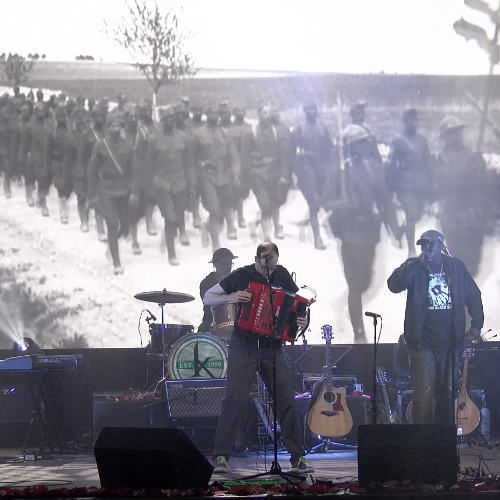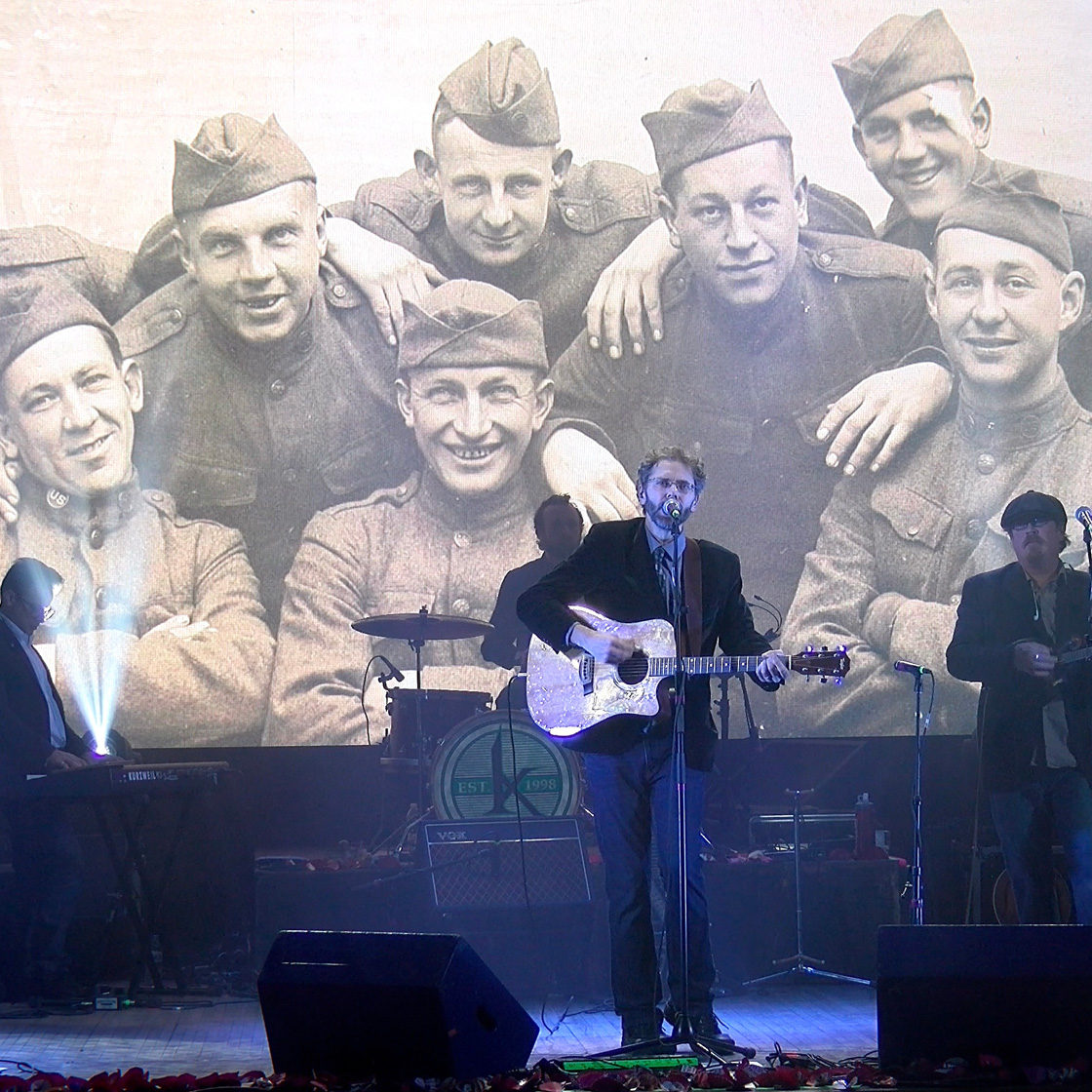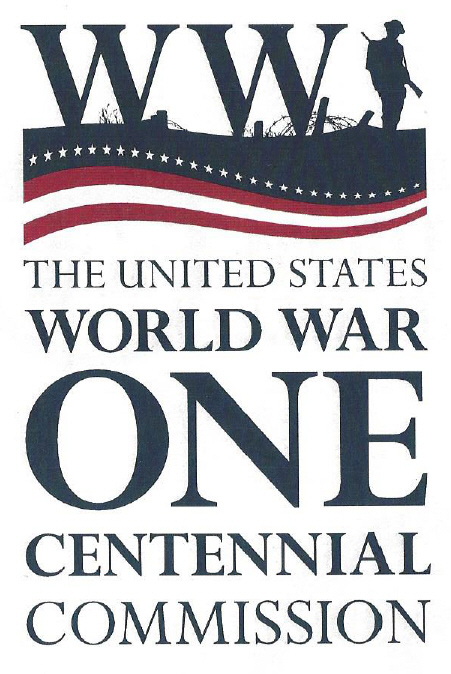Trailer for the 2019 production on the UW-Madison campus
About The Greatest War
How are the events of World War One relevant to us today? Have we moved past this conflict, or are we still struggling with its consequences?
The Greatest War examines these questions in a multimedia, live music exploration of the modern, living legacy of WWI and the uneasy truce that ended it.
First performed in front of a sold out crowd on November 11, 2018–100 years to the day after the Armistice–at the historic Barrymore Theatre, this rock ‘n’ roll history show lays bare that legacy while searching for meaning in The War to End War.


Kissers frontman and The Greatest War’s Artistic Director Ken Fitzsimmons describes this as his most ambitious project to date. He has long had a passion for World War One and has written eight songs specifically for this independently produced show.
Sean Michael Dargan, The November Criminals, and The Viper & His Famous Orchestra also perform original music inspired by WWI while projections of photos, film, and artwork serve as a backdrop to the performance.
Many of those images are generously donated by the Wisconsin Historical Society and Wisconsin Veteran’s Museum. The LED video wall to display them was donated by Blizzard (2018) and Studio Gear (2019). The lighting and scenic design is by Antishadows, and the complexity of performing this production is handled expertly by Four Seasons Theatre.
The stage lights fade up and The Kissers accompanied by nearly the entire ensemble take the audience through the entire war in just a few minutes. It starts from the peace that preceded it, moves to America’s–and Wisconsin’s–entrance into the war, and ends with a frenzied count up to the eleventh hour of the eleventh day of the eleventh month when the war ended.
And then all at once it stops. Chimes ring eleven times. On the screen behind them are images of people from 1918. Onstage a narrator reads how Wisconsin soldiers told it in their letters home: after four years and millions dead there is an Armistice – the great war is over.
But what was this war, how did it impact people, and do we underestimate how it has affected us? To start to understand that the audience has begun situated in the war torn world of 1918. But from there they will travel further back in time to get a glimpse of what WWI looked and felt like to Wisconsinites who at first were passive observers, but later became active participants. Carried by the words, the images, and the music of the Kissers and other musicians, they will get to cast this all forward, to reflect on what the war might mean to us in the present day.
No prior knowledge of World War One is needed to enjoy this concert. You only need an appreciation for good music and thoughtful lyrics along with a willingness to glimpse at the courage, despair, optimism, anger, hope, and sense of foreboding experienced back then by so many of our fellow human beings.

Trailer for the 2019 production on the UW-Madison campus
About The Greatest War
How are the events of World War One relevant to us today? Have we moved past this conflict, or are we still struggling with its consequences?
The Greatest War examines these questions in a multimedia, live music exploration of the modern, living legacy of WWI and the uneasy truce that ended it.
First performed in front of a sold out crowd on November 11, 2018–100 years to the day after the Armistice–at the historic Barrymore Theatre, this rock ‘n’ roll history show lays bare that legacy while searching for meaning in The War to End War.


Kissers frontman and The Greatest War’s Artistic Director Ken Fitzsimmons describes this as his most ambitious project to date. He has long had a passion for World War One and has written eight songs specifically for this independently produced show.
Sean Michael Dargan, The November Criminals, and The Viper & His Famous Orchestra also perform original music inspired by WWI while photos, film, and artwork serve as a backdrop to the performance.
Many of those images are generously donated by the Wisconsin Historical Society and Wisconsin Veteran’s Museum. The LED video wall to display them was donated by Blizzard (2018) and Studio Gear (2019). The lighting and scenic design is by Antishadows, and the complexity of performing this production is handled expertly by Four Seasons Theatre.
The stage lights fade up and The Kissers take the audience through the entire war in just a few minutes. It starts from the peace that preceded it, moves to America’s–and Wisconsin’s–entrance into the war, and ends with a frenzied count up to the eleventh hour of the eleventh day of the eleventh month when the war ended.
And then all at once it stops. Chimes ring eleven times. On the screen behind them are images of people from 1918. Onstage a narrator reads how Wisconsin soldiers told it in their letters home: after four years and millions dead there is an Armistice – the Great War is over.
But what was this war, how did it impact people, and do we underestimate how it has affected us? To start to understand that the audience has begun situated in the war torn world of 1918. But from there they will travel further back in time to get a glimpse of what WWI looked and felt like to Wisconsinites who at first were passive observers, but later became active participants. Carried by the words, the images, and the music of The Kissers and other musicians, they will get to cast this all forward, to reflect on what the war might mean to us in the present day.
No prior knowledge of World War One is needed to enjoy this concert. You only need an appreciation for good music and thoughtful lyrics along with a willingness to glimpse at the courage, despair, optimism, anger, hope, and sense of foreboding experienced back then by so many of our fellow human beings.

PROGRAM
Below is the program for The Greatest War. Many of the songs are preceded by the reading of quotes of soldiers, nurses, politicians, and citizens who lived during the time. The music is played to a screen displaying images, film and posters from the time along with headlines from Wisconsin newspapers.
PROLOGUE – The Armistice
Overture to The Greatest War – The Kissers
An instrumental interpretation of the war with musical references to songs in the show. Builds in volume and then ends suddenly–much like the Armistice abruptly silenced the guns.
11th Hour
The Armistice began on November 11, 1918 at 11:00am—the eleventh hour of the eleventh day of the eleventh month. 11 chimes followed by a brief silence will commemorate the 100th anniversary of the Armistice.
The War Won – The Kissers
Using a melody from Edward Elgar’s Cello Concerto written in the aftermath of the war and building on a quote by WWI poet Edmund Blunden that no one could win the war, “the War Won, and would keep on Winning.”
Why Does It Have to Be Me – The Kissers
A conversation / argument between three people over the Armistice and what would later become the Treaty of Versailles. Each is a “dramatic composite” incorporating a real person and many others. In order they are Germany, France, America, and then France and America talking over each other.
ACT I – Europe’s War, The World’s War
Wir sitzen so fröhlich beisammen – Katie Norman (voice and accordion)
This song was popular in Wisconsin in 1914. Sung in German, it’s an anti-war song about Napoleon. It will be accompanied by images of German-American musicians in Wisconsin at the time.
It’s a Long Way to a World War – The Viper & His Famous Orchestra
A reworking of the early 20th century song It’s a Long Way to Tipperary. This song depicts the naivete of much of the world that war seemed impossible among countries who were experiencing globalized commerce for the first time. This song was a collaborative effort between Ken Fitzsimmons (The Kissers) and Ryan Jerving (The Viper).
Belgium Put the Kibosh on the Kaiser – The Viper & His Famous Orchestra
An actual song from WWI, this somewhat ridiculous number is bordering on musical propaganda. Although Belgium put up a fight against the invading Germans, they didn’t stand a chance against one of the largest armies in the world at the time.
Silent Night – Joe Nosek
Most of the world–including Wisconsinites–believed the war would be over by Christmas. When it was not over on Christmas Day, 1914 one of the most extraordinary events ever recorded in wartime took place. All along the front both sides stopped fighting, came out of their trenches and conversed, exchanged gifts, and even played soccer.
Over the Top – November Criminals
Living up to its name, this incredulous number by Milwaukee’s polka hip-hop band features all three rappers in the group. Each has his own take on the meaning of “over the top.”
And the Band Played Waltzing Matilda – The Kissers
Written by Scottish-Australian Eric Bogle this beautiful and sad song depicts a young Australian who gets sent to fight in Gallipoli, Turkey which was then part of the Ottoman Empire, and loses both legs. As the song plays, the video will show images of the many people of the world who fought in the war including Indian, Senegalese, Turkish, and more.
In the Belly of the Lusitania – Sean Michael Dargan with John Wedge and friends
The sinking of the passenger ship Lusitania was the first step in making Americans feel uneasy about their neutral attitude towards Germany. Although the ship actually had ammunition on it, the public didn’t know that at the time–the government kept that secret. A couple years later, the German navy employed the tactic of “unrestricted submarine warfare” which meant any ship on the sea, neutral or not, would be sunk. This was the last straw for the U.S. who declared war shortly thereafter.
The Traitor State – The Kissers
Days before the U.S. declared war, there were referendums around Wisconsin asking if citizens supported a declaration of war. The answer was a resounding “no.” One senator (Bob LaFollette) and 9 of 11 representatives voted against the declaration of war, and shortly thereafter Wisconsin got the nickname “The Traitor State.” I got a lot of the ideas of the lyrics from a great lecture by Leslie Bellais.
Over There – The Kissers
Probably the most famous song in the U.S. from the war. Written by George M. Cohan, our version takes a little more subdued tone.
ACT II – Wisconsin in the War
Dear Mother – The Kissers
The lyrics of this song share the stories of three “boys” from Wisconsin who went overseas. Very often the descriptions of soldiers’ experiences came from letters addressed to their mothers. Images displayed will include pictures of these and other Wisconsinites who served.
Happiest Mortal/The Best That You Can – The Kissers
This is a medley of two songs involving Helen Bulovsky who grew up on Few Street in Madison and went to WWI as a nurse. “Happiest Mortal” is sung in the first person by her and is based on her letters and diaries which I got from the book Finding Helen: The Letters, Photographs and Diary of a WWI Battlefield Nurse: Brooke B. Cameron, Janice C. Collins. “The Best That You Can” is a combination of two poems–“My Creed” by Howard Arnold Walter and “Life’s Mirror” by Madeline S. Bridges–that Helen collected, considering them words to live by.
She Works On Cars – The Kissers
About women at home and in the war, then and now. This was a product of a couple different influences. One was an exhibit at the WI Historical Society by Simone Munson that is about women in the war. And the second was from conversations with my wife Maggie and the podcast Emotional Labor: The Invisible Work (Most) Women Do | Dear Sugars.
ACT III – The War to End War
The Marseilles – Hanah Jon Taylor
An African-American regiment out of Harlem, the Hellfighters, contained a band led by jazz musician James Reese Europe. He is credited with introducing jazz to Europe. Many people were amazed to hear the way this group would “swing” a marching band tune. One of the songs they played was the French national anthem The Marseilles.
No Man’s Land – November Criminals
About the Sherman Plaza uprising in Milwaukee in 2016. We have reapplied it to the “Red Summer” of 1919 when black soldiers who fought in the war returned home to face segregation.
Reading: Dolce et Decorum Est by Wilfred Owen
The Recruiting Sergeant – The Kissers
An Irish song that depicts a witty exchange between and Irishman and an English Sergeant trying to recruit him into the army. Images will include headlines and photos of the end of empires and revolutions as a result of the war with a nod to the rebellion in Ireland in 1916.
How Ya Gonna Keep ’em Down on the Farm (After They’ve Seen Paree)? – The Viper & His Famous Orchestra
The title pretty much sums up the topic of this World War One era song. We find it analogous to the U.S. as a nation that was just becoming a super power. The video screen will depict images of planes, tanks, blimps, battleships, and gas attacks–what at the time was brand new technology, but has stayed in warfare for the past 100 years.
They All Made Peace (What Is Peace?) – The Viper & His Famous Orchestra
This song explores the question of why World War One was fought. Analogous to any war, there is often only a vague idea by any side of what peace actually looks like. The images will tie in how the Armistice and the Treaty of Versailles in 1919 helped lead to a second World War.
Reading: In Flanders Fields by John McCrae
No Man’s Land/Flowers of the Forest – The Kissers/Sean Michael Dargan (bagpipes)
Another one by Eric Bogle. This is a quintessential WWI song. The singer is sitting next to the grave of William McBride and talking to him and asking questions about the war. The screen will display the names of the 2,459 Wisconsinites who died in the war.
The Best That You Can Reprise
This is our chance to thank all the performers and leave on an inspirational note of how me might learn from the sacrifices of those who lived during WWI.
PROGRAM
Below is the program for The Greatest War. Many of the songs are preceded by the reading of quotes of soldiers, nurses, politicians, and citizens who lived during the time. The music is played to a screen displaying images, film and posters from the time along with headlines from Wisconsin newspapers.
Overture to The Greatest War – The Kissers
An instrumental interpretation of the war with musical references to songs in the show. Builds in volume and then ends suddenly–much like the Armistice abruptly silenced the guns.
11th Hour
The Armistice began on November 11, 1918 at 11:00am—the eleventh hour of the eleventh day of the eleventh month. 11 chimes followed by a brief silence will commemorate the 100th anniversary of the Armistice.
The War Won – The Kissers
Using a melody from Edward Elgar’s Cello Concerto written in the aftermath of the war and building on a quote by WWI poet Edmund Blunden that no one could win the war, “the War Won, and would keep on Winning.”
Why Does It Have to Be Me – The Kissers
A conversation/argument between three people over the Armistice and what would later become the Treaty of Versailles. Each is a “dramatic composite” incorporating a real person and many others. In order they are Germany, France, America, and then France and America talking over each other.
Wir sitzen so fröhlich beisammen – Katie Norman (voice and accordion)
This song was popular in Wisconsin in 1914. Sung in German, it’s an anti-war song about Napoleon. It will be accompanied by images of German-American musicians in Wisconsin at the time.
It’s a Long Way to a World War – The Viper & His Famous Orchestra
A reworking of the early 20th century song It’s a Long Way to Tipperary. This song depicts the naivete of much of the world that war seemed impossible among countries who were experiencing globalized commerce for the first time. This song was a collaborative effort between Ken Fitzsimmons (The Kissers) and Ryan Jerving (The Viper).
Belgium Put the Kibosh on the Kaiser – The Viper & His Famous Orchestra
An actual song from WWI, this somewhat ridiculous number is bordering on musical propaganda. Although Belgium put up a fight against the invading Germans, they didn’t stand a chance against one of the largest armies in the world at the time.
Silent Night – Joe Nosek
Most of the world–including Wisconsinites–believed the war would be over by Christmas. When it was not over on Christmas Day, 1914 one of the most extraordinary events ever recorded in wartime took place. All along the front both sides stopped fighting, came out of their trenches and conversed, exchanged gifts, and even played soccer.
Over the Top – November Criminals
Living up to its name, this incredulous number by Milwaukee’s polka hip-hop band features all three rappers in the group. Each has his own take on the meaning of “over the top.”
And the Band Played Waltzing Matilda – The Kissers
Written by Scottish-Australian Eric Bogle this beautiful and sad song depicts a young Australian who gets sent to fight in Gallipoli, Turkey which was then part of the Ottoman Empire, and loses both legs. As the song plays, the video will show images of the many people of the world who fought in the war including Indian, Senegalese, Turkish, and more.
In the Belly of the Lusitania – Sean Michael Dargan with John Wedge and friends
The sinking of the passenger ship Lusitania was the first step in making Americans feel uneasy about their neutral attitude towards Germany. Although the ship actually had ammunition on it, the public didn’t know that at the time–the government kept that secret. A couple years later, the German navy employed the tactic of “unrestricted submarine warfare” which meant any ship on the sea, neutral or not, would be sunk. This was the last straw for the U.S. who declared war shortly thereafter.
The Traitor State – The Kissers
Days before the U.S. declared war, there were referendums around Wisconsin asking if citizens supported a declaration of war. The answer was a resounding “no.” One senator (Bob LaFollette) and 9 of 11 representatives voted against the declaration of war, and shortly thereafter Wisconsin got the nickname “The Traitor State.” I got a lot of the ideas of the lyrics from a great lecture by Leslie Bellais.
Over There – The Kissers
Probably the most famous song in the U.S. from the war. Written by George M. Cohan, our version takes a little more subdued tone.
Dear Mother – The Kissers
The lyrics of this song share the stories of three “boys” from Wisconsin who went overseas. Very often the descriptions of soldiers’ experiences came from letters addressed to their mothers. Images displayed will include pictures of these and other Wisconsinites who served.
Happiest Mortal/The Best That You Can – The Kissers
This is a medley of two songs involving Helen Bulovsky who grew up on Few Street in Madison and went to WWI as a nurse. “Happiest Mortal” is sung in the first person by her and is based on her letters and diaries which I got from the book Finding Helen: The Letters, Photographs and Diary of a WWI Battlefield Nurse: Brooke B. Cameron, Janice C. Collins. “The Best That You Can” is a combination of two poems–“My Creed” by Howard Arnold Walter and “Life’s Mirror” by Madeline S. Bridges–that Helen collected, considering them words to live by.
She Works On Cars – The Kissers
About women at home and in the war, then and now. This was a product of a couple different influences. One was an exhibit at the WI Historical Society by Simone Munson that is about women in the war. And the second was from conversations with my wife Maggie and the podcast Emotional Labor: The Invisible Work (Most) Women Do | Dear Sugars.
The Marseilles – Hanah Jon Taylor
An African-American regiment out of Harlem, the Hellfighters, contained a band led by jazz musician James Reese Europe. He is credited with introducing jazz to Europe. Many people were amazed to hear the way this group would “swing” a marching band tune. One of the songs they played was the French national anthem The Marseilles.
No Man’s Land – November Criminals
About the Sherman Plaza uprising in Milwaukee in 2016. We have reapplied it to the “Red Summer” of 1919 when black soldiers who fought in the war returned home to face segregation.
Reading: Dolce et Decorum Est by Wilfred Owen
The Recruiting Sergeant – The Kissers
An Irish song that depicts a witty exchange between and Irishman and an English Sergeant trying to recruit him into the army. Images will include headlines and photos of the end of empires and revolutions as a result of the war with a nod to the rebellion in Ireland in 1916.
How Ya Gonna Keep ’em Down on the Farm (After They’ve Seen Paree)? – The Viper & His Famous Orchestra
The title pretty much sums up the topic of this World War One era song. We find it analogous to the U.S. as a nation that was just becoming a super power. The video screen will depict images of planes, tanks, blimps, battleships, and gas attacks–what at the time was brand new technology, but has stayed in warfare for the past 100 years.
They All Made Peace (What Is Peace?) – The Viper & His Famous Orchestra
This song explores the question of why World War One was fought. Analogous to any war, there is often only a vague idea by any side of what peace actually looks like. The images will tie in how the Armistice and the Treaty of Versailles in 1919 helped lead to a second World War.
Reading: In Flanders Fields by John McCrae
No Man’s Land/Flowers of the Forest – The Kissers/Sean Michael Dargan (bagpipes)
Another one by Eric Bogle. This is a quintessential WWI song. The singer is sitting next to the grave of William McBride and talking to him and asking questions about the war. The screen will display the names of the 2,459 Wisconsinites who died in the war.
The Best That You Can Reprise
This is our chance to thank all the performers and leave on an inspirational note of how me might learn from the sacrifices of those who lived during WWI.














